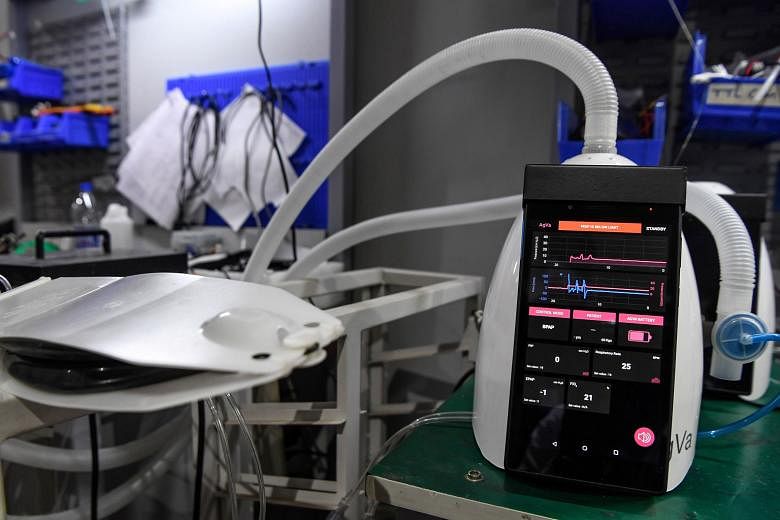Indian-made ventilators are at the centre of a controversy after doctors in four major hospitals rejected hundreds of them as not fit for use for Covid-19 patients last week.
Furthermore, in the two months when manufacturers had produced thousands of ventilators, it also emerged that ventilators might not be as vital to Covid-19 care as previously thought.
With more than 849,000 infections and over 22,600 deaths, India is now the third worst-affected country in the world.
When hospitals sounded the alarm, saying there were only 47,000 ventilators in the country, with imports costly and difficult, given global travel restrictions, the government decided to go local.
In May, the Indian government contracted 16 local manufacturers to make 60,000 cost-effective ventilators in two months. It allotted 20 billion rupees (S$370 million) from the PM Cares Fund to purchase the machines.
Most of the manufacturers sped up production and cut costs by skipping more advanced features.
Start-up AgVa Healthcare and state-owned Bharat Electronics Limited (BEL) - in collaboration with healthcare company Skanray - received the bulk of the order with 10,000 and 20,000 units each, respectively.
However, after receiving 175 ventilators funded by the PM Cares Fund, the Lok Nayak Jai Prakash Narayan Hospital, Delhi's largest hospital for Covid-19 care, said last week that the machines did not have BiPAP, a key non-invasive option to supply oxygen without intubation. Of these, 155 were from BEL and 20 from AgVa.
Most Covid-19 patients in India have needed only non-invasive ventilation, and only those with worsening conditions are put on invasive ventilation.
In invasive ventilation, a tube is inserted down the patient's throat into the lungs, after which the machine takes over the patient's breathing.
The non-invasive technique supplies oxygen via a face mask.
Dr Sumit Ray, an intensivist at Delhi's Holy Family Hospital, said: "Mild to moderate cases improve with oxygen therapy or non-invasive ventilation (BiPAP).
"If the patient is unable to breathe on his own, then we intubate. Both methods are important for the management of Covid-19, but we try a non-invasive method first to prevent any possibility of further damage to the lungs."
That was not the only complaint. Doctors at the Mumbai-based Sir J.J. Group of Hospitals issued a report saying the machines were not able to reach peak targets of oxygen saturation and indicate the actual levels of inspired oxygen or FiO2 delivered to the patients. Patients who were perspiring and becoming "restless" while using this ventilator showed "immediate signs of improvement" when shifted to other brands of ventilators.
"We are of the opinion that the AgVa ventilators cannot cater to the critical care of Covid-19 patients," the doctors concluded, and returned 81 machines.
Dr Deepak Agrawal, a neurologist and co-inventor of AgVa ventilators, however, said: "Someone donated our lower-end model of ventilators to the Mumbai hospitals. These don't have a built-in oxygen blender, but are perfectly suitable for Covid-19 care through intubation. A third-party technician's improper demonstration and installation led to the dissatisfaction of the doctors."
But an official from the Sir J.J. Group of Hospitals said their report had highlighted deficiencies that "cannot be simply attributed to improper installation".
Dr Agrawal said: "Indian doctors are used to imported high-end ventilators priced at 1.5 million to two million rupees. Although our ventilator lacks all the bells and whistles, it provides the same core functionalities."
AgVa ventilators are priced at 150,000 rupees, a tenth of the imported ones. BEL's machines are priced at 400,000 rupees each.
Dr Jagadish Hiremath, an interventional cardiologist who evaluated the BEL ventilators, said that the non-invasive BiPAP option was "a luxury" and would have "prolonged manufacture".
The issues have raised questions about the type of ventilators best suited to Covid-19 care, and whether the Indian government overestimated the nation's need for them.
Like most at the start of the pandemic, India had assumed ventilators were crucial to save those with severe illness. But as understanding of Covid-19 evolved, more doctors are using non-invasive techniques.
Dr Lancelot Pinto, a consultant respirologist with Mumbai's Hinduja Hospital, said at least 60 per cent to 70 per cent of his patients recovered with only non-invasive care: "When a person infected with the coronavirus deteriorates... the blood vessels could be inflamed but the lungs are still compliant. We then need to pump more oxygen and help the patient breathe better."
If a patient comes in late with acute respiratory disorder, doctors will immediately intubate him.
Health Ministry data as of June 23 shows that only 4.16 per cent of Covid-19 patients required ventilator support, while about 16 per cent needed oxygen.
The Straits Times could not independently verify the features of the Indian-made ventilators supplied to the hospitals, but given the complaints and rejections, many doctors now worry if the machines are reliable.
BEL and AgVa representatives are speaking to the hospitals concerned and exploring upgrades.

